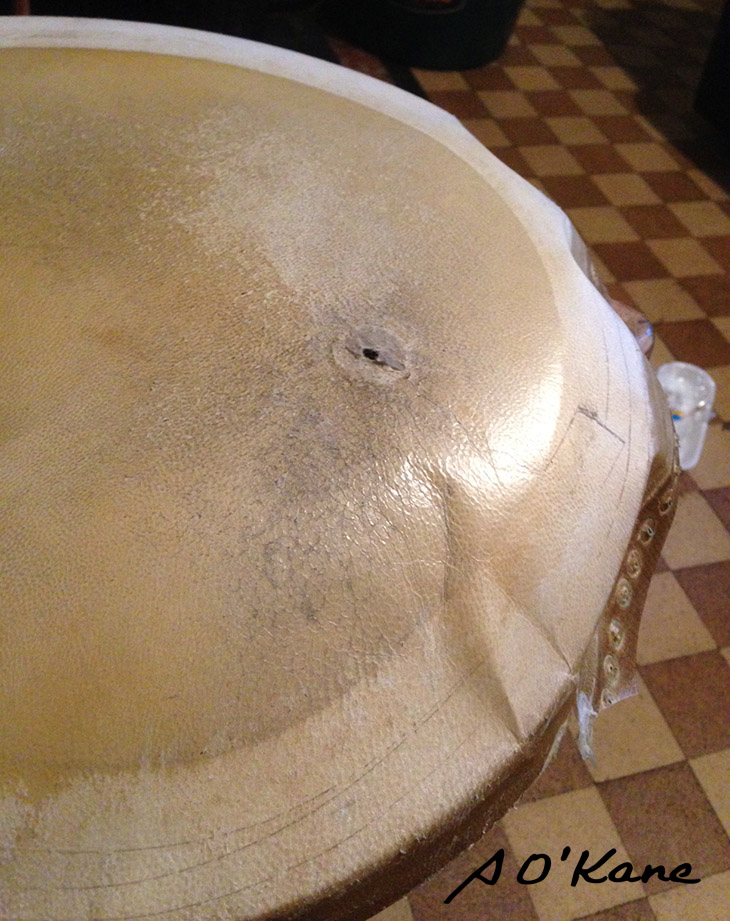
Bodhrán Stick Design
In many parts of Ireland the normal way to play a bodhrán was by hand. Most styles were backhand, some with knuckle or knuckles, some with finger or fingers and some had a forehand style using some elements from Italian and Basque techniques. Frequently old drums had cymbals. See Tony McMahon’s Clarebannerman YouTube videos. Sticks, when used, were generally heavy with ball ends.
Right from the first the first time I saw stick players, it was interesting to me how so many sensitive players successfully moderated the sound by what they added to their sticks… glove fingers, wool leather, chamois, cloth tape, medical bandages, electrical tape. Seeing such a variety of ideas was a great education, particularly at an age when the normal bodhrán sounded gruesome.
Lathe workers who were not players were supplying the music shops with the definitive sticks that were better suited at the back of the fire to make the tea. Peadar Mercier’s stick was lighter than most. Johnny MacDonaghs sticks were lighter again and about 9.5” long. Gino Lupari’s was lighter again and he was very particular that the weight of his sticks matched the thickness of the Lambeg skins and thus lighter and slightly shorter than Johnny’s, thicker at the ends and tapering towards the middle.
When Tommy Hayes won the All Ireland Bodhrán Competition in the early' 80s, all my ideas about sticks changed. His use of a thin, short, light stick was captivating to watch and his playing proved that the use of light thin sticks could be very effective, less exhausting and much more musical and sensitive.
Since I was locked into what is now called the Kerry style, as played by Johnny McDonagh, I mixed Tommy’s lightness and thin grip size and Johnny’s stick length of 9.5”. Hence my adoption of the fiddle bow type of stick.
So, by accepting as correct the grip thickness that fiddle bow makers had developed over these past 400 years, and the whippy type of wood that they most commonly used (brazilwood-pernambucco) and forsaking the ball end in favour of a straight stick, a new design emerged... (Any whippy dense wood particularly yew is good for these sticks. Ebony, although dense, has little spring)
Seamus O’Kane.
I now sell 3 types of stick:
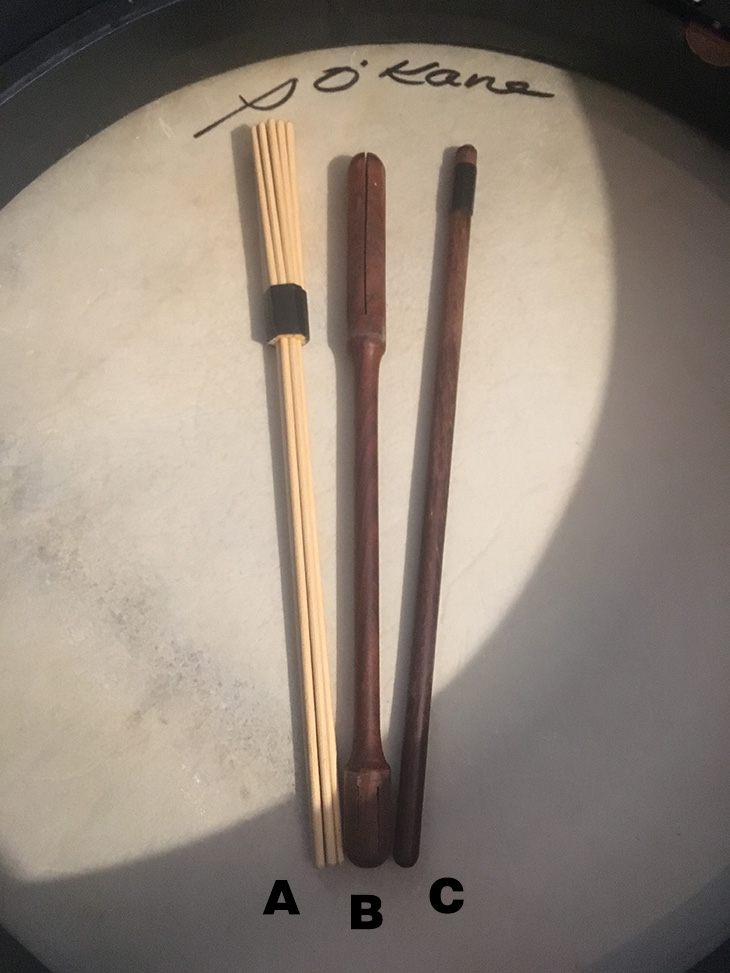
Stick A
This is the "Bunched Dowels stick". It is made from ramming dowels. It developed from the bunched skewer type that I had developed 50 years ago. Unlike the dangerous skewer type sticks, each dowel is individually, safely rounded so that they won't damage the skin. No particular technique is required to play using this stick. It is suitable for both single and double end playing. For single end players, it has the unique feature, in that the end can be fishtailed for altered and absolute control. A great additional feature, that prevents stick rotation whilst playing.
Stick B
This Split stick is a new design to many but I have been making and improving this type for these past 40 years. The design evolved from efforts to soften the sound of the stick on the skin. Later on, it was an attempt to revive the rim playing from the old Kerry styles where players alternated from playing on the skin, to playing on the rim. Ordinary solid ended sticks give an unacceptably hard rattle, grating to the ear. These sticks give a nice light clicky sound and bounce back extremely quickly. Crucially the grip size is 8.5mm and again the length is 240mm (9.5 inches) and made from rosewood. It is much livelier than the 'ordinary' skewer type sticks, yet gives the same soft sound.
Stick C
This is simply the fiddle bow type made from rosewood, with a slightly weighted end for balance. The rosewood has the right density and springiness - not too light and not too heavy. The fiddle bow makers have agreed after 300 years of testing that 8.5 mm is the best grip diameter. It has no balls on the ends, no ridges in the middle and no rubber grip aids to change the optimum diameter size. This stick is light and fast to use and good players agree that the balance is very good. It is just about the right weight for use on medium to light skins and 240mm (9.5 inches) long. Many good teachers recommend this stick.
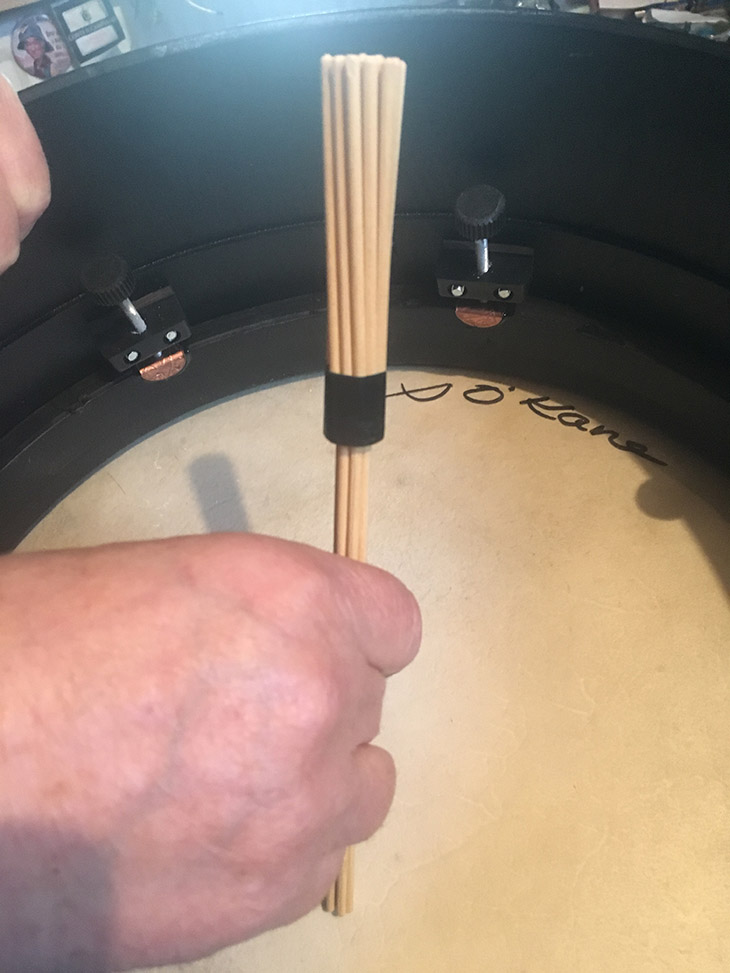
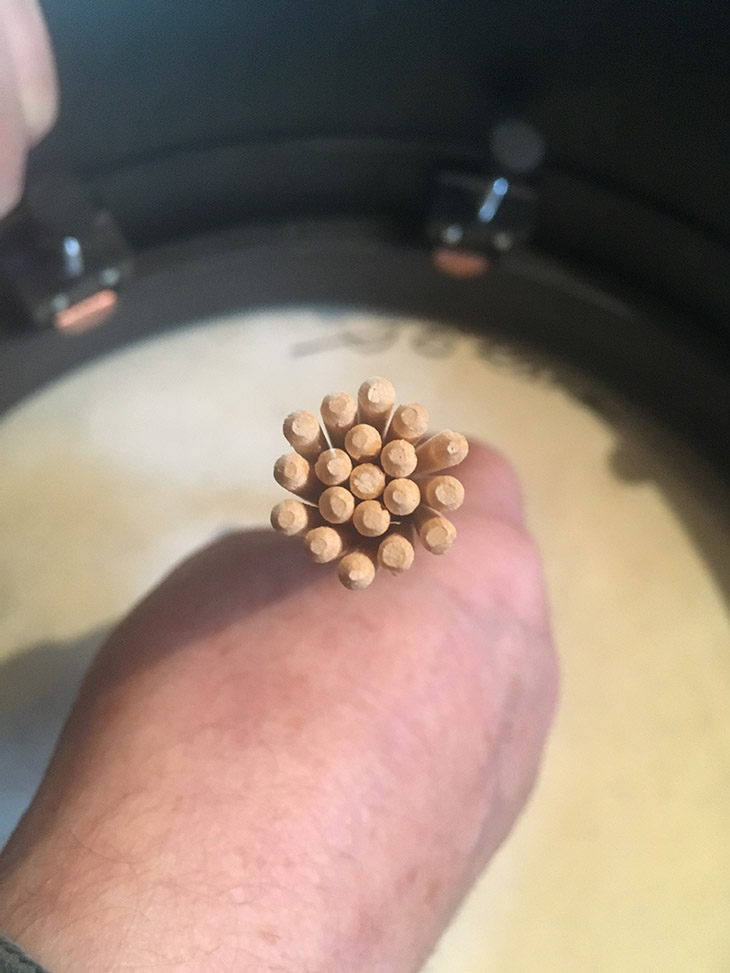
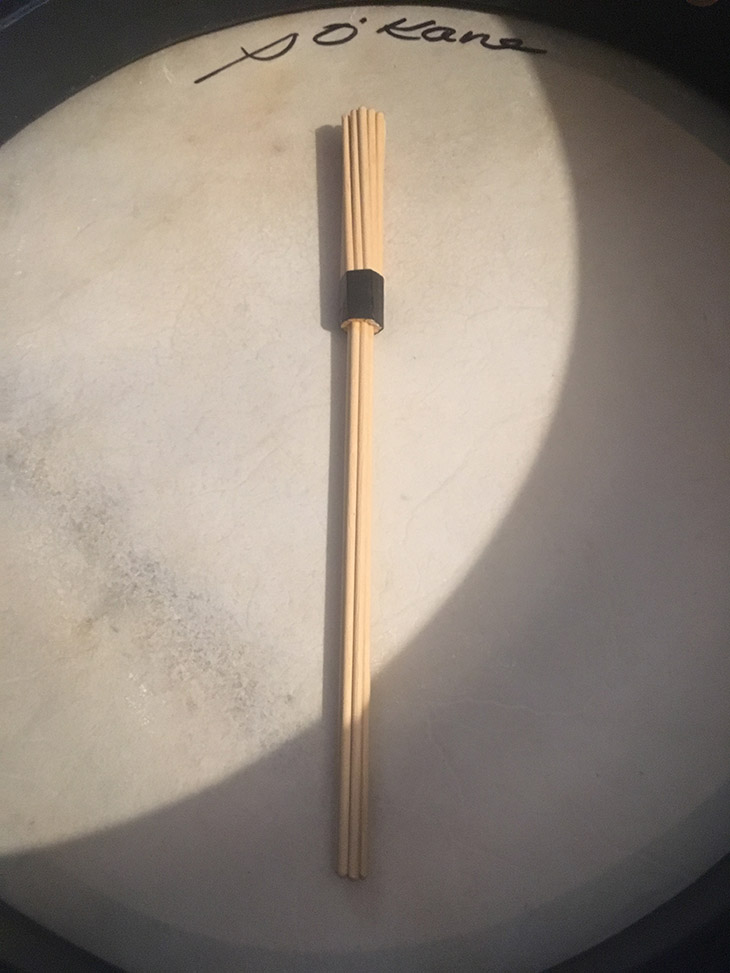
To explain Fishtailing... in "Stick A" (the "Bunched Dowels stick")
Last year whilst experimenting on ideas to counter stick slippage, I discovered that when a stick strikes the skin, the friction between it and the skin causes the stick to rotate slightly on each downward stroke. I got Guy Blitgen and some other players to test and confirm, by playing it, that this is indeed correct.
Should you wish to confirm this for yourself, wrap and knot a length of fine thread where you grip your stick. As you play, you will find that the knot does rotate under your fingers. It's amazing that it took me 50 years to discover this.
I discussed this problem with Ray Gallen. His stick design totally eliminates the problem, because he has broad flat piece sanded into his stick (that he made 30 or 40 years ago). Because of this broad flat grip piece, it can't rotate. So from Ray's design, I got this idea.
To counter this problem of frictional rotation, the new design allows for the ends of the stick to be softly squeezed into a fishtail shape, as shown clearly in the series of photographs below. This totally eliminates the rotation. Single end players should find this feature a great advantage, requiring only a light grip... the bounciness of the stick being the big advance.
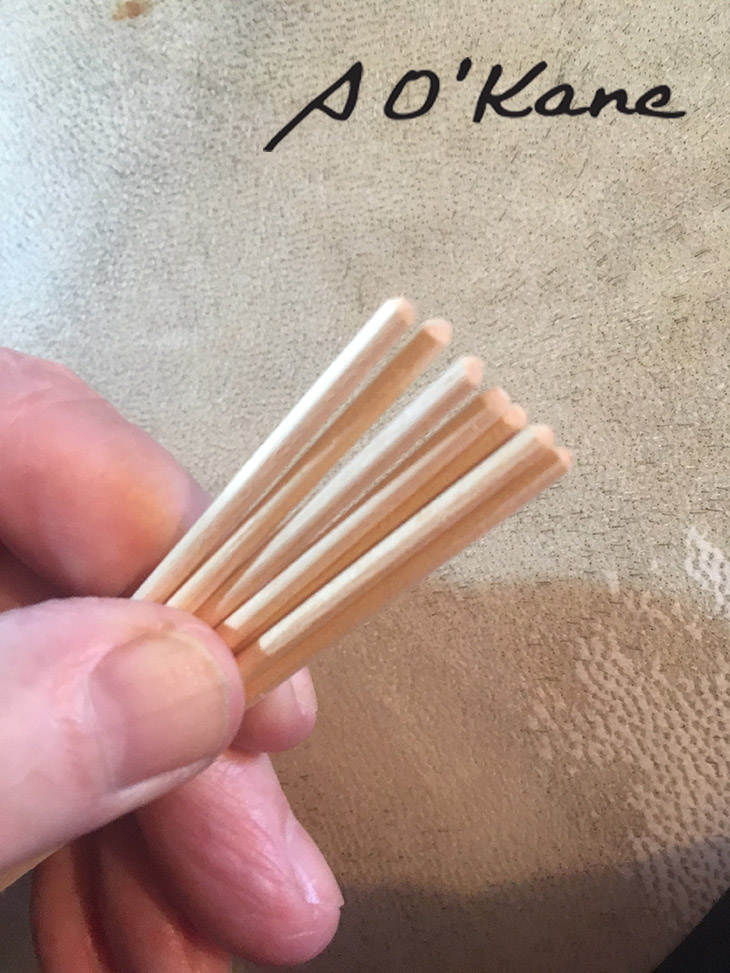
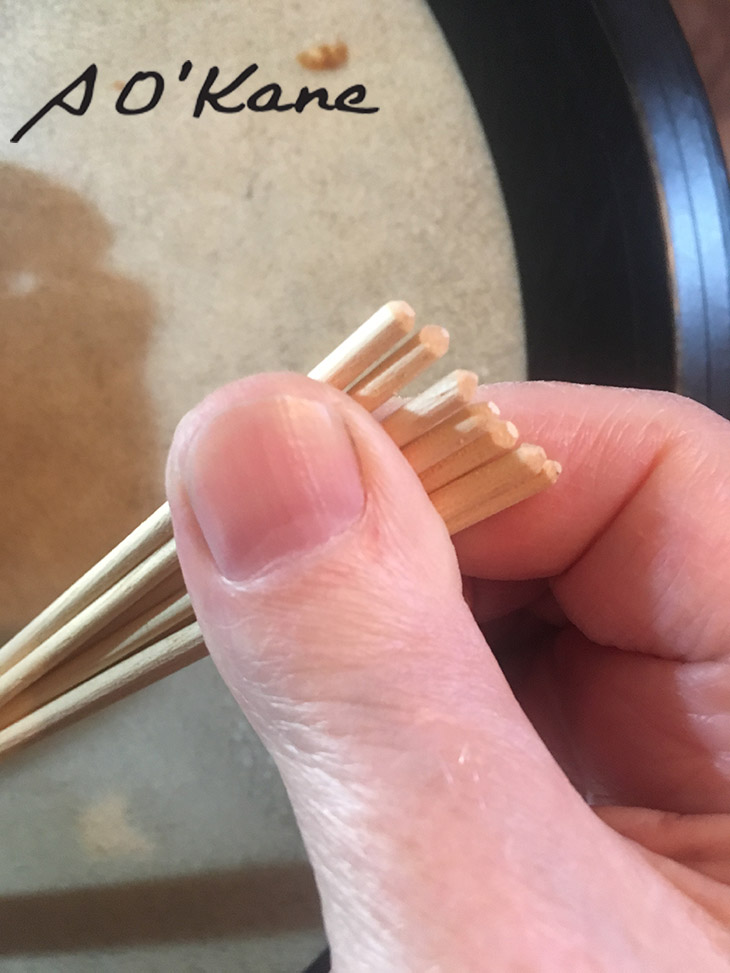
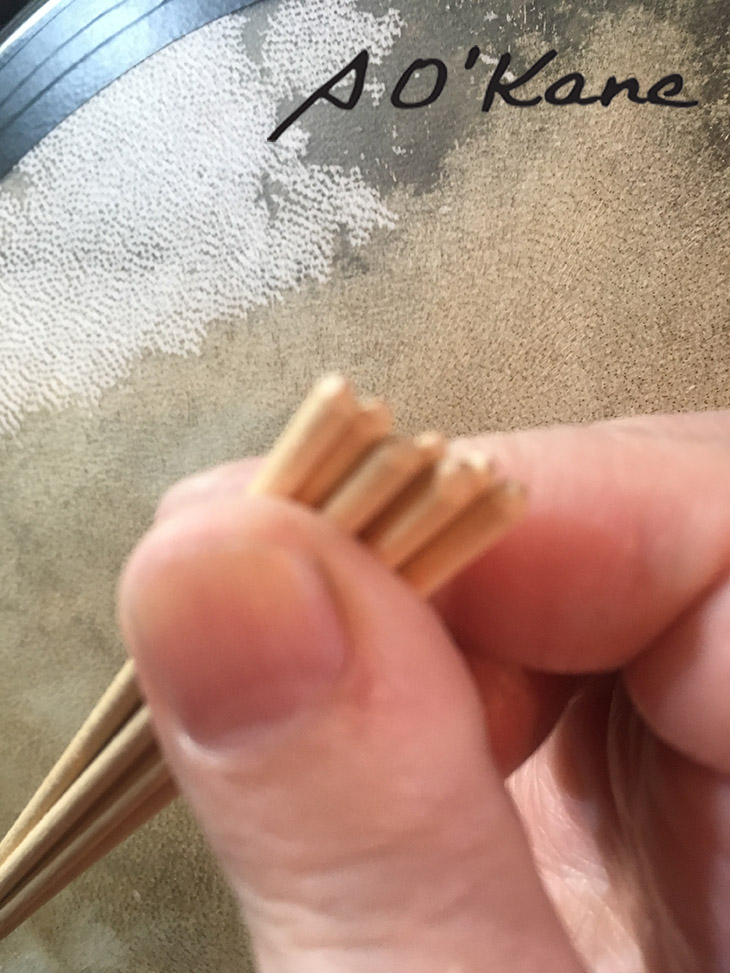
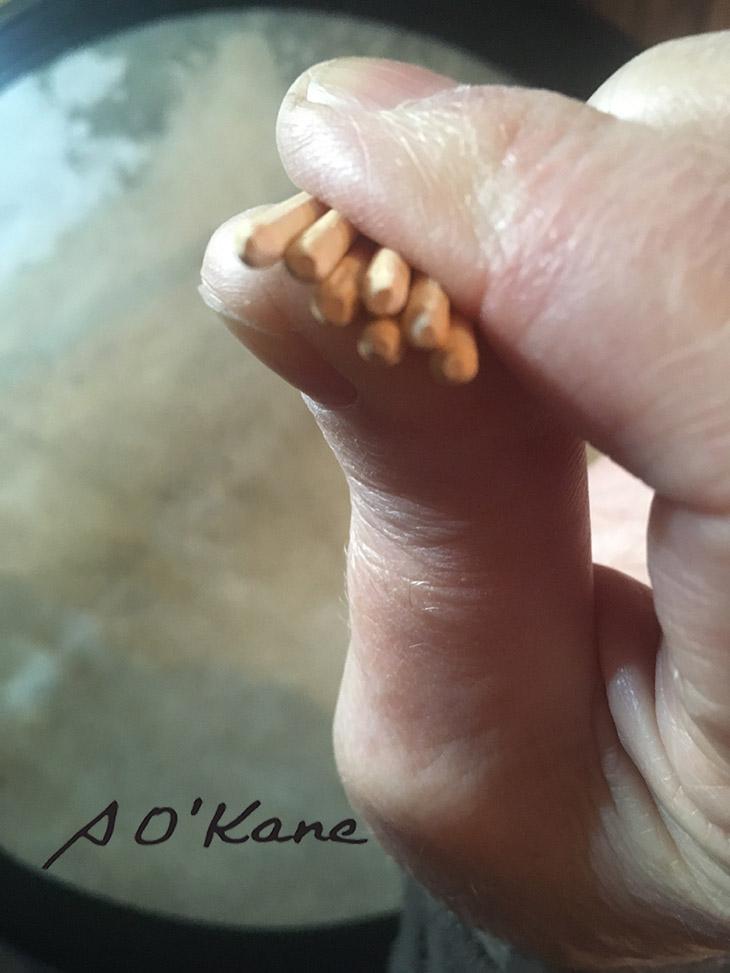
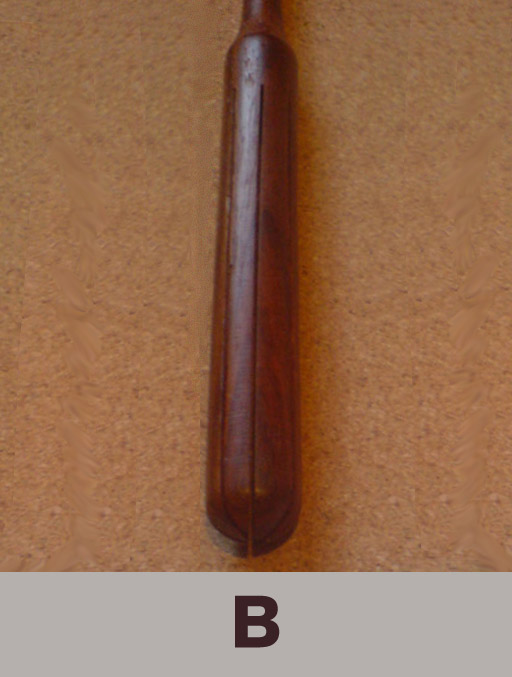
Irmine Blanc bodhrán sticks - (added to webstie; 1st March, 2016)
At Le Bono Festival last week, I met Irmine Blanc, a very good bodhrán player with a style of her own. In the class we discussed dangerous skewer type sticks... and how badly-made versions can destroy bodhran skins.
We had discussed the thin grip fiddle bow thickness also and its advantages for a player. 3 days later she sent me these photos of what she had just made. One brilliant design.
The middle stick is from 8mm diameter Yew, which is a wood of the correct density and it flexes beautifully. It is my favourite wood to use for sticks. Split into 4 segments, this core flexes in harmony with the outside ring of skewers. Every end of each skewer is rounded, as can be seen in Photo 1.
Used as in photo 2, it is suitable for single end playing. With the added end, for balance, as in photo 4, it is perfect for double end playing. Congratulations, Irmine and thanks for giving me permission to post it here. Simply brilliant.
Sticks and photos by Irmine Blanc:
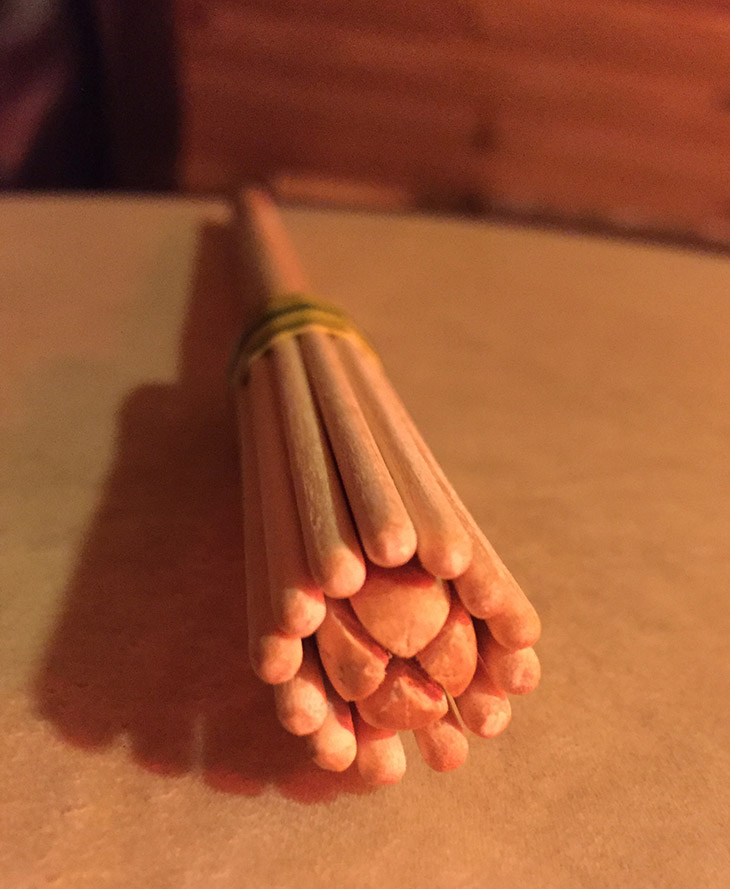
Photo 1
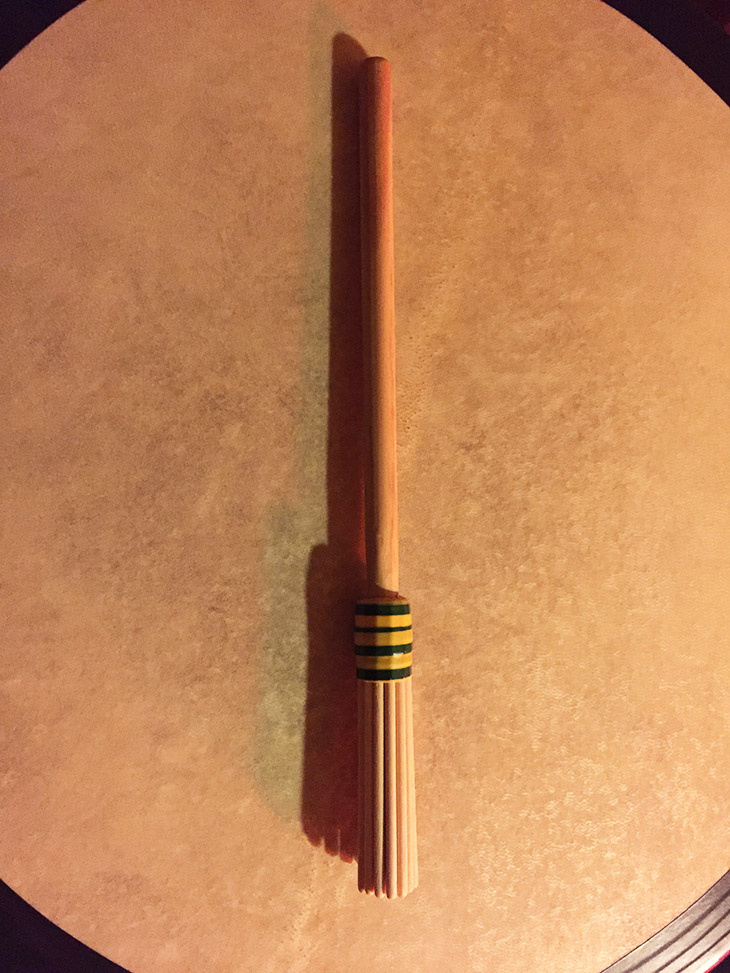
Photo 2
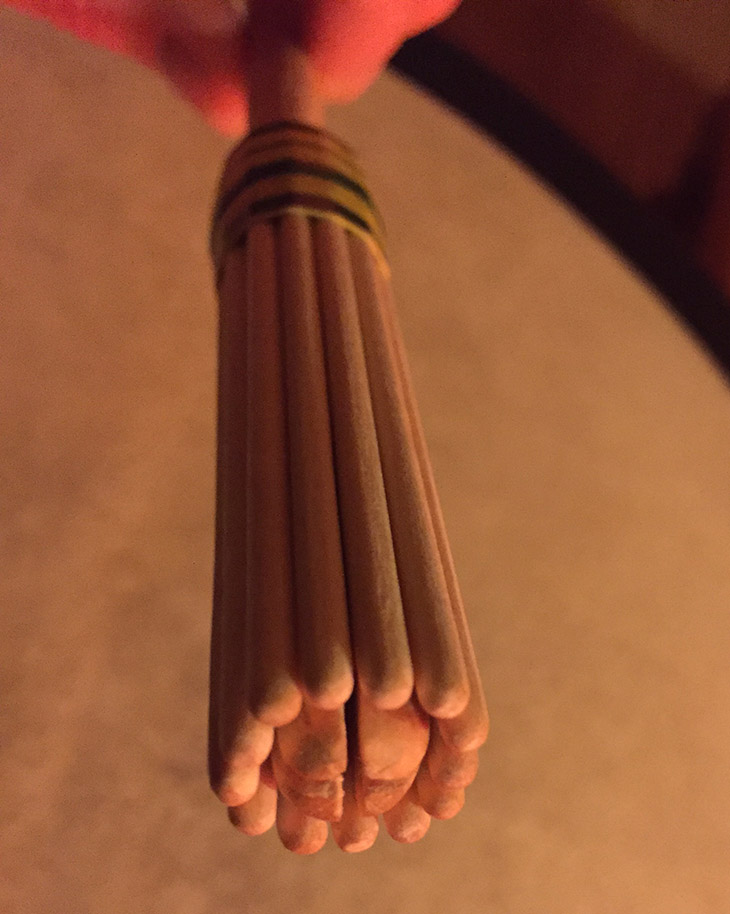
Photo 3
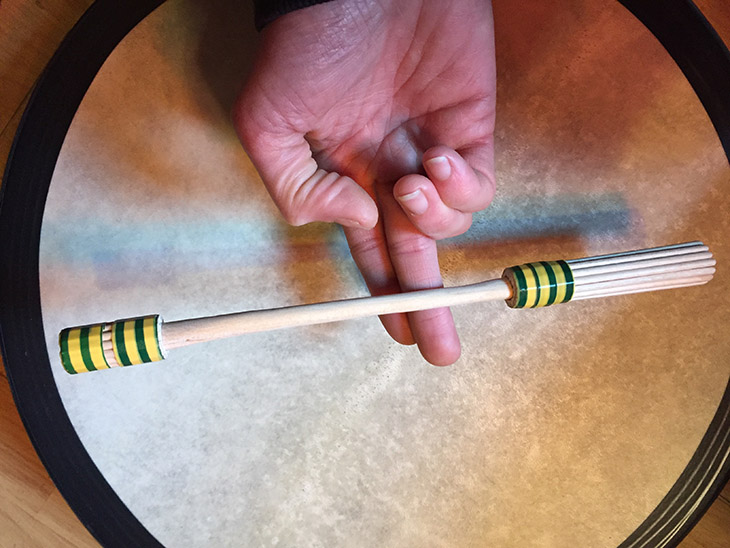
Photo 4
Irmine Blanc’s sticks... Update - 4th May, 2016
Further to the above information Irmine has taken protection on her design and is now offering them for sale. I have tested them and highly recommend them.
She has made some dimensional and material changes. The length and diameter of the core or handle has been made exactly the same length and balancing point as my split stick and fiddle bow type designs... and the diameter of the core is exactly the same as mine.
I have asked Irmine to do this so that players who use my sticks have a constant weight, diameter and length in all 3 types.
I used to make the skewer type, but abandoned it in favour of the split stick type 3 or 4 years ago. I have seen so many terrible and downright dangerous attempts to make this type that I am nervous when I see a new attempt.
Irmine’s design is excellent in that it answers all the design problems with simplicity. Since so many players love the hotrod sound I could not praise this design enough.
Features:
These sticks are now available from Irmine Blanc: irmineblanc@gmail.com
They cost is 20 euros ... postage extra... payment via Paypal to Irmine’s email address.
Contact her for other payment methods.
Stick Slippage. - (added to webstie; Wednesday, 9th May, 2018)
In these past few years, I with other players, have been trying to solve the problem of the stick slipping whilst playing. Following the designs of; violin bow makers, pen and pencil makers, I make the central gripping region of the stick thin (8-10 mm).
Players who prefer thicker grip diameters and have become used to that, may not have to worry about this delicate point. …but still the slippage problem persists whatever the grip diameter, or playing style.
In the past, many solutions have been tried; each according to the playing style. Rubber bands, leather loops, non-slip stuff glued to the stick, flat areas etc. Each works a bit, but all have faults that fail when the pressure of hard playing happens. Just when the player needs to excite, the slipping starts.
Recently, I have been experimenting with sticky pads of all types that I can find on Amazon. To do this, I wrapped them to the stick using fine thread, to fix them to the stick in a belt and braces fashion, to be sure to be sure that they would stay in place. The thread had to be knotted to hold.
Whilst playing, I noticed that the knot kept rotating with each strike. …just a small bit each time. SMALL, BUT VERY, VERY SIGNIFICANT! I have been playing for 50 years and I have only noticed this now. To make sure that it’s not me or my playing method, I got Guy Blitgen to confirm that it is really happening.
So instead of 1 problem there are 2. Slippage lengthwise, and rotational slippage, that is caused by the friction of the stick being turned by the skin. It took me 50 years to discover that. Stupid or what?
In all my years of stick making I have tried all the existing solutions rubber or non-slip stuff, loops of leather, cut-out nicks, bumps, grooves and flats, an unending search with each solution having faults.
Since I firmly believe that the thin grip is best, the rotational friction is magnified when the end of the stick has a greater diameter than the middle. So, for my sticks the problem is big… but the solution evident.
I will now copy Ray Gallen’s solution with his permission. He has been using for years… since The Stone Age, it is said. He copied it from Fred Flintstone. His stick has a long parallel flat area the full length of the grip area. If the flat is not the full length of the grip area it will cause problems. That solution will counter the rotational forces and isolate the problem of longitudinal slippage.
Further to this solution, there is a product on the market for drummers. It is called “Sex Wax”. It will further reduce the frictional rotation. It can be got here: www.GrahamRussellDrums.com …as can Gorilla Snot, that has not dried up.
Many of the suppliers of Gorilla Snot on Amazon or eBay sell dried up tubs that are unusable. You can rely on Graham Russell’s products to be as fresh and of the highest quality. He also supplies the latest drum stuff that may be of use to bodhrán players who wish to experiment.
Seamus O’Kane
Photo of Damaged skin (below). Notice the epidermic layer stabbed to a dull patch around the hole.
The importance of using properly made skewer type sticks is reinforced by this skin which I am repairing today... notice the dull patch and the hole. I get at least 20 of these per year. Please take the warning!!!
This damage is caused by constant use of skewer bunches glued together and the ends of the bunch rounded on a sander creating needle sharp ends. Buyer Beware.
When the skin is struck the individual skewers flex and stab back the skin causing this damage. I have spent 30 years repeating this warning... in vain as far as many stick makers are concerned. Irmine's Design solves the problem, and is totally safe to use.
